 |
Site created 12/15/97.

page created: 4/6/09
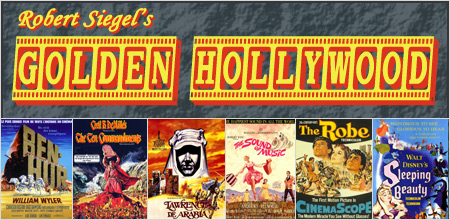 Robert Siegel - Main Page NOTE: The scans below are the property of Robert Siegel and The Digital Bits, and may not be reposted without permission. Copyright of the images belongs to the respective studios. In addition, please note that all the information contained within the text is taken from ORIGINAL studio press materials, which may contain some errors. |
Welcome classic fans! This is our first column covering a film that has no current release on DVD or Blu-ray Disc. But there is an excellent reason for it. As you may know, Bits contributor and film restoration expert Robert A. Harris has recently announced the commencement of an effort to restore the roadshow version of The Alamo. The film is in very bad condition and if the restoration is not done immediately, the elements will be lost and we may never see the movie the way it was meant to be seen. Unfortunately, when the film was edited to a shorter version, the original negative was also cut (against the wishes of John Wayne). The roadshow version was found at a film exchange in Toronto in 1991 and was released on laserdisc (with generally poor quality compared to what can be done today with a full restoration). But now, 18 years later, the print is terribly faded and has "vinegar syndrome," which makes the film itself disintegrate and become sticky. Robert says that now available is technology to restore the film. The aim of this restoration is to bring the film back to its former glory in 70mm 6-track stereo and to make possible a high-quality presentation release on both Blu-ray Disc and DVD. CORPORATE DONATIONS FOR THIS PROJECT ARE NOW BEING ACCEPTED - you'll find all the necessary information at the end of this column (below). Let's save this classic epic from extinction!
The Alamo Film appreciation by Robert Siegel of The Digital Bits They stood firing until they could stand no longer... 156 MEN AGAINST A RAGING ARMY OF 7000! So exclaimed the posters and advertisements for one of Hollywood's most famous historical epics. In 1836, Colonels David Crockett, Jim Bowie and William Travis, with 182 untrained volunteers, defended a crumbling Spanish mission against 7,000 battle-hardened professional soldiers led by the dictator general Santa Anna. With their lives they bought 13 days of precious time which General Sam Houston used to raise and train the army that subsequently routed Santa Anna and freed Texas from his tyrannical rule. This is the dramatic story on which the all-time box-office favorite, John Wayne, spent more than $12 million and nearly 14 years of research and planning to bring to the screen. This is The Alamo. [Continued below...] |
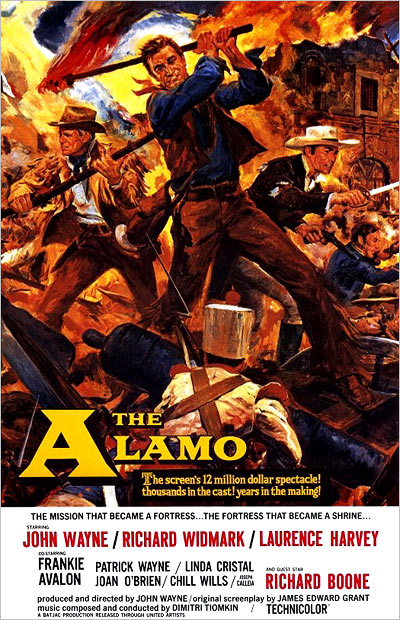 |
The United Artists release, written by James Edward Grant, shot over a period of 83 days (September to December of 1959), was said to be the most expensive and most spectacular motion picture ever produced in the United States. No previous film had ever captured on film such panoramic grandeur in its battle scenes or ever recorded such hand-to-hand combat as this brutally frank film in which every defender of the Alamo is slain. Wayne, who directed as well as produced the film, also stars as the Tennessee backwoods ex-congressman, Colonel David Crockett, who rode 1500 miles on horseback to join Texas' bitter fight for independence. Richard Widmark, versatile star of many Hollywood productions at the time, plays the leather-tough Jim Bowie and talented Laurence Harvey is starred as Colonel William Barrett Travis, who commanded the forces at the Alamo. Of the extraordinary production cost, Wayne's Batjac company was reported to have spent in excess of $4 million for supplies, salaries, fees and daily wages in the tiny Texas community. Since Wayne had to get a good portion of his financing from wealthy Texans, they insisted the film be shot there. Local economists claimed that this income upgraded the basic economy of the area for the next decade. And for decades to come afterwards, the $1,500,000 recreation of the Alamo and the town of San Antonio de Bexar, which Wayne created, were opened to the public as a tourist attraction. The blueprints of the original Alamo were used to re-create the version used on the set. The complete set for The Alamo would take 2 years to build. The picture, according to master movie-maker John Ford at the time exclaimed, "Is the most important motion picture ever made. It will run forever."
[Continued below...] |

|
John Wayne, who for 14 years cherished the dream of bringing this epic to the screen said of it shortly after completing the climactic battle scenes, "This is going to shake hell out of people all over the world. And that is what I want most of all to accomplish. I want to remind the freedom-loving people of the world that not too long ago there were men and women in America who had the guts to stand up and fight for the things they believed in." That is the message and the inspiration of The Alamo. It is not subtle, indirect, or oblique. It is a message that was applicable to today's world and to today's America, leading the fight for the preservation of man's liberties and his dignity. "The people of the Alamo," said Wayne, "realized that in order to live decently a man must be prepared to die decently. There were no namby-pamby pussyfoots or skedaddle in that brave land. They were rough, lusty, hard-fighting, hard-drinking, hard-loving men who held to one common conviction, that freedom is worth fighting and dying for, and they gave their last drop of blood to be true to it. In San Antonio, Texas, the Alamo is venerated as a sacred shrine, but it does not belong to Texas alone. It belongs to people everywhere who value the priceless treasure that has always been bought with blood: freedom."
[Continued below...] |
 Original theatre lobby cards. |
"Duke" John Wayne, born Marion Robert Morrison (according to his birth certificate) came to California on a high-school scholarship and during a summer vacation from the University of Southern California he worked as prop man with the then Fox Film Corporation. Here he met the famous producer-director John Ford. When, after Wayne's career as the first singing cowboy on record, Walter Wagner signed Ford to direct Stagecoach he got his big break. Ford called Duke and offered him the part of the Ringo Kid in the now classic film. Stagecoach was highly successful artistically and financially, and Wayne was hailed as a new screen star. However, he did not enjoy instant success. His screen reputation built slowly over a period of several years, during which time he made many good pictures such as Reap the Wild Wind, The Long Voyage Home and Back to Bataan. His name on a picture came to assure success at the box office and exactly 20 years after he began his career and 10 after he got his big opportunity in Stagecoach, Wayne was voted the most popular male star in the entire industry by all of the leading trade magazines including Boxoffice, The Motion Picture Herald and Motion Picture Exhibitor, which were the three industry trades read widely by the industry including the theater owners.
[Continued below...] |
 The Duke on the set of The Alamo. |
The tidal wave of Wayne's popularity continued with such hits as Tycoon, Fort Apache, Wake of the Red Witch, She Wore a Yellow Ribbon and Sands of Iwo Jima for which he won an Academy Award nomination. At the time of production of The Alamo, he was married to the former Pilar Palette of Lima, Peru. They made their home in Encino and had a daughter, Aissa, who actually appeared in the film. He had four children from a previous marriage. One of them, Patrick, had a featured role in the film. Wayne would play 142 leading roles. His favorite moment which resulted from his fame was becoming the Grand Marshall of the Tournament of Roses Parade in 1973. He was said to have cherished that event. He would finally win his Academy Award in 1969 for True Grit. When production began on The Alamo, Wayne re-mortgaged his home in Hollywood to help finance the film, but the film would lose him a great deal of money personally. He would make one film after another following The Alamo to get back on the right financial footing. As for financing from other investors, Wayne, who had intended to play just a small role (Sam Houston), was forced to take the lead, which he had intended for Richard Widmark. Wayne had wanted only a small role so he could cast his attention on other aspects of the film. The entire project of The Alamo was said to be so stressful for Wayne that he smoked over five packs of cigarettes a day and had trouble cutting down his intake afterwards. Over the last years of his life Wayne was beset with medical problems. In 1964 he had a cancerous lung removed, in 1978 heart-valve replacement surgery and in 1979 his stomach was removed. The 6' 4" superstar died on June 11,1979 from stomach and lung cancer.
[Continued below...] |
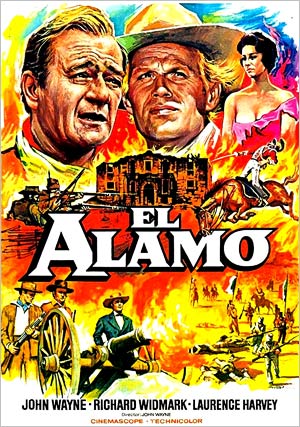 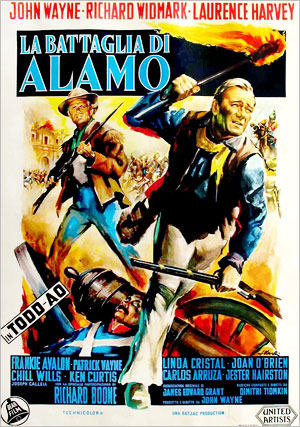 |
Ever since Richard Widmark pushed an old lady down the stairs in Kiss of Death, he became one of Hollywood's most sought-after actors. This time around he would star as good-guy Colonel Jim Bowie. After two years of teaching acting, Widmark decided it would be more exciting to become a thespian and his perfect diction soon landed him on several big radio programs as well as numerous soap operas which schooled him in all types of characterizations. He finally made his Broadway debut in the juvenile lead of Kiss and Tell, which established him, and next he was the lead in William Saroyan's Get Away Old Man. Then Tommy Udo was born. As written, this psychological thriller in Kiss of Death was a nasty thoroughly hateful character. "He was a louse," Widmark said of the man he portrayed, "But I had such fun doing the role because it was so intense and involved every acting skill I had ever learned." From that point on, the story of Richard Widmark speaks for itself with role after role in some of Hollywood's top films. It was Carlos Azzura's fame as a bull fighter that won him his role in The Alamo. There was an excellent reason for this typecasting. Azzura, considered by many to be one of the greatest matadors, performed in the classic Portuguese style, on horseback, and was easily the most accomplished horseman on the Alamo set. Sr. Arruza made his film debut in the movie as a cavalry lieutenant in the army of Mexican General Santa Anna. Richard Boone began his career in New York eleven years before The Alamo film, and rose to stardom in almost every type of acting medium. It was to him that John Wayne immediately turned when he was casting the role of General Sam Houston. Originally born in Los Angeles, Boone got his start as an actor in New York and did not return to the West Coast until he had appeared in about 75 dramas. Evenings, during this time, Boone studied with the group at famed Actors' Studio. His first screen assignment was that of the nerve-wracked colonel in Halls of Montezuma followed by films in which he played both heroes and heavies with equal ease. Shortly after his contract expired he accepted the lead in the Medic series and became famous. Worried about becoming typecast as a doctor, Boone was happy when the Medic series ended in 1957 and he was able to start his top rated series Have Gun Will Travel. Jester Hairston, who with quiet dignity plays the heart-warming role of the slave, Jethro, was an ASCAP composer with more than 50 published songs, a nationally-known director and arranger of choral music, a writer of serious books on folk music, a teacher and lecturer in constant demand at colleges and music schools and finally a polished actor with more than 100 major film and TV credits. A graduate of Tufts University in Boston, where he majored in music, and later, a student of music theory at Julliard Conservatory of Music, Hairston first made a reputation in show business as assistant conductor of the famed Hall Johnson Negro Choir of New York and worked for 13 years with this celebrated group, going to Hollywood with them in 1936 to do the choral music for Green Pastures. In 1943, he organized his own choir. As an actor, Hairston was perhaps best known for his characterization of Leroy on the popular Amos and Andy TV show.
[Continued below...] |
      L to R (Top): Alamo star John Wayne, Richard Widmark and Laurence Harvey.
L to R (Top): Alamo star John Wayne, Richard Widmark and Laurence Harvey.L to R (Bottom): Frankie Avalon, Carlos Arruza and Patrick Wayne. |
The Alamo set was constructed on the ranch of James T. Shahan. Fourteen miles of tar roads were constructed for easy access to the set. New sewer and water lines had to be constructed as well. Said Wayne many years later, "We built an entire town from the ground up. It was one of the most stressful but amazing periods in my life to finally realize that my long-awaited dream of bringing The Alamo to the screen was finally being realized." Chatto Rodriguez was the general contractor on the set, who in-turn worked with art designer Alfred Ybarra to make everything as authentic as possible, even using rare drafts found in local museums. Almost a thousand hand-made bricks were then used to construct the Alamo Mission walls, which would be used in dozens of westerns later on. Many wells were dug, so that over 11,000 gallons of water could be supplied. All American pictures at the time were required to meet the rigid specifications of the S.P.C.A. So when those horses fall in the production, they were doing only what they were trained for. No horse was allowed to be tripped by hidden wire, as was done in the early days of film making. These horses were so well trained that their own salaries were higher than some of the actors. A record number of 18 of Hollywood's most expert practitioners of the "dry high dive" were brought to Bracketville, Texas by John Wayne to execute the action scenes of the spectacular battle. It is a testament to their superb skill that, despite a number of daring horse-falls staged for the first time on any set of a motion picture, not one of The Alamo stunt crew sustained any injury worse than a skinned knee or sprained wrist, and, of course, none were severely hurt. Unlike most stunt work for outdoor action films, which is quickly worked out on the spot, the big Alamo scenes involving powder charges and falling horses were planned months before the actual filming began. The stuntmen spent countless hours in rehearsal with their "falling horses," all of which were individually owned and trained. The most spectacular group horse-fall ever recorded on film, involving a mass pile-up of 14 horses and riders, was shot during the last few weeks on location. This scene called for a troop of Mexican cavalry to clear the lowest barricade of the Alamo with a precisely timed jump, then to go down in a pile under a point-blank cannon blast from the Alamo defenders. After a few test jumps, the 14 stuntmen did the scene perfectly.
[Continued below...] |
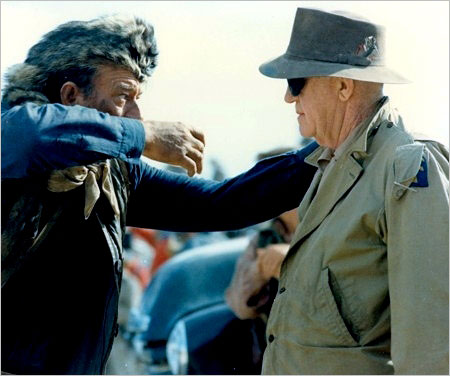
John Ford visits The Alamo set. |
One of the props that needed to be an exact replica of the original was the famous, but most-dreaded and efficient infighting weapon of the American frontier, Jim Bowie's famous knife. No one knows where it is now, and they didn't know when filming began so museums were searched to find the closest type of weapon and through these designs the knife was re-created. What is known is that the weapon must have been in his hand when he was run through by over a dozen Mexican bayonets in the chapel of The Alamo. Credit for devising the knife was generally given to Jim's older brother, Rezin P. Bowie, who whittled out a wooden design with a protective guard and a single-edged blade eight and one quarter inches long, of a peculiar curved shape and with a needle sharp point. It was an inch and a quarter at its greatest width. Richard Widmark, who portrayed Bowie in the movie, was taught by experts for several weeks how Bowie was known to use the knife and later told the press that he considered those movements to be one of the hardest details he had ever needed to learn for a picture.
[Continued below...] |

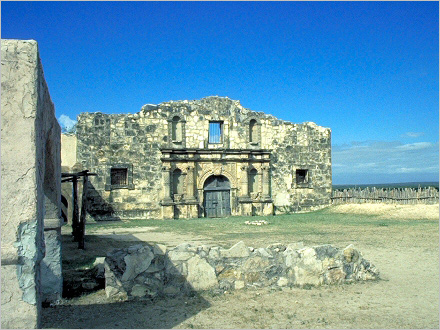 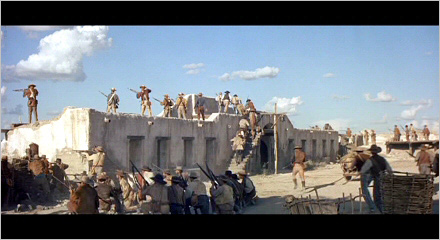
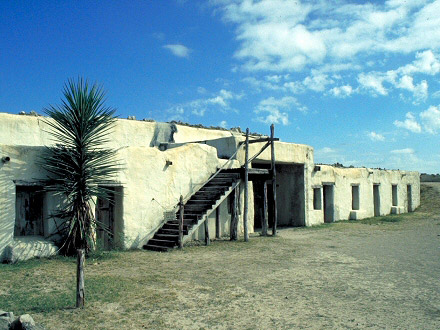 Comparisons of The Alamo set as seen in the film, and as it survives today. |
Multi-Academy-Award-Winner Dimitri Tiomkin wrote the music for The Alamo. It would end up becoming one of his largest undertakings. He spent over four months composing the score, and changing the feel of the music as Wayne changed scenes. The music contains as its theme the melody from which the durable Green Leaves of Summer was written. Dimitri's mother was a piano and music teacher. After studying at St. Petersburg Conservatory in Russia, he appeared on stages as a child pianist. But with the Russian revolution and World War I, he decided to move elsewhere. He moved to Germany in 1921. He began to put on concerts there and in France. He immigrated to the United States in 1923. On his concert tour, he met composers George Gershwin, Richard Rodgers and Jerome Kern. Soon after, he was able to incorporate several of his compositions in the Shubert theaters and with Florenz Ziegfeld, Jr. In 1933, he went to Hollywood, where he learned that he was unhappy with the movie studio system. One of his first projects after several small jobs at MGM was for Paramount in Alice in Wonderland. One of his most successful partnerships turned out to be with director Frank Capra, including Lost Horizon and It's a Wonderful Life. He would go on to score films for Alfred Hitchcock and many of Hollywood's well known classics such as Duel in the Sun, Red River, High Noon, Giant, Guns of Navarone, The Old Man and the Sea and The Unforgiven as well as several theme songs for TV series such as Rawhide. Wayne liked his work in westerns and felt he was the only man to score The Alamo.
[Continued below...] |
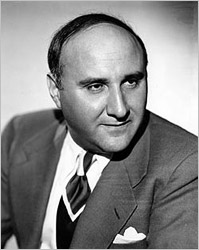   L to R: Composer Dimitri Tiomkin portrait, with his Academy Award and at the piano. |
Production of The Alamo was not without its problems. During one of the takes, a cannon rolled over the foot of Laurence Harvey. His foot was broken at the instep. Still, he continued with the scene until a good shot was produced. Mrs. Guy, a very small role played by LeJean Eldridge, was murdered during the film's production. Word leaked causing some bad publicity for the film, but the murder had nothing to do with her on-set duties or the film itself. Cast as an extra, it was the only film she ever made. Famous was the constant bickering between John Wayne and Richard Widmark. Widmark was a liberal democrat who opposed blacklisting and supported gun control and the civil-rights movement. All of these positions were completely opposite of Wayne's beliefs. But Widmark, in later years, blamed the problems on Wayne's complete lack of directing skills. He said that "Wayne had absolutely no experience in motivating an actor for a scene." Widmark was so unhappy and felt that he was miscast so he tried to leave the film only a week after production began. He only stayed due to threats of legal action. More problems occurred when John Ford showed up one day to ask Wayne if he could direct some of the picture. It is recorded that Wayne sent Ford to film some second-unit shots, mostly of the Mexican calvary, but Wayne ended up using very little, if any, of Ford's footage. Another problem was with Richard Boone. For his first day of filming, he appeared wearing a full beard which Boone had spent much time trimming and grooming. Wayne told him that his character had no beard, and he refused to film for several days until he finally gave in and shaved. Chill Wills, who played a beekeeper in the film, caused problems for Wayne after the film's release by imposing an aggressive campaign to win the Best Supporting Actor Oscar, taking out an ad in Variety in which the film's cast were praying harder for him to win an award than the defenders of the Alamo had prayed to win the battle. This upset Wayne so much that he took out a full page ad himself countering it. Other problems during filming involved the nuance of thousands of crickets and grass-hoppers, which routinely jumped unwanted into the camera's view.
[Continued below...] |

Modern sign directing visitors to the original sets. |
Charlton Heston was offered two different roles in the film, Jim Bowie and Colonel William Travis. But Heston did not want to be directed by Wayne because he feared critical response to a right-wing movie (According to Heston, Wayne had intended the epic to be an allegory for America's Cold War with the Soviet Union). Heston (along with Clark Gable, who was offered a role and turned it down) in later years said they were sorry for not accepting the roles they were offered. Interested in a small role was Sammy Davis Jr., who asked if he could play one of the slaves. But Sammy Davis Jr., at the time, was seeing a white woman, May Britt, who would become his wife. Hollywood did not like the idea of this interracial relationship and so Wayne refused him any role in the film. Sammy Davis Jr. was said to have told Wayne that he understood and was not upset about not being cast.
[Continued below...] |
 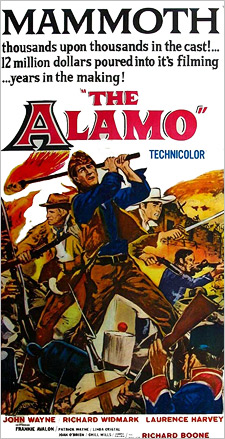
|
Russell Birdwell was hired as Wayne's unit publicist for the film. He would then hire professional photographers to photograph the shoot and publicity stills to be used to promote the movie. Russell had previously worked on Prisoner of Zenda, Gone with the Wind and Rebecca. He was later portrayed in The Scarlet O'Hara War for TV because of his position on Gone with the Wind. He would generate a $93,000.00 campaign for Wayne's directorial debut, only partially funded by United Artists. His trade ads in Boxoffice Magazine would proclaim, "Perhaps the Oscar should say something more this year than it has ever said before." John Wayne was said to dislike this kind of publicity. Donald Clark and Christopher P. Andersen published John Wayne's The Alamo: The Making of John Wayne's 1960 Epic Film in 1994. The book was an extensive behind-the-scenes look at the film but is sadly out-of-print but is still available only at collector's prices. Wayne spent a lot of his time promoting this film. He and Birdwell convinced seven states to declare an Alamo day in the period prior to release.
[Continued below...] |
 
Left: Alamo music was released on many different albums. Right: Life Magazine printed an extensive story on the film. |
Released on October 24, 1960, after 9 months in post-production, The Alamo would eventually cost $12 million to make, and after its initial release and reissue in 1967, would gross $9.9 million dollars. Years after the idea hit Wayne to make the film, it would be turned down by several studios when United Artists committed 2.5 million to production and agreed to distribute the film. After its L.A. premiere the film was cut by approximately 26 minutes by order of United Artists, against Wayne's demands to keep the film as it was. Missing from the roadshow cut were the original overture, intermission and end themes, the "Jefferson Speech" extended between Col. Travis & Cap. Dickinson, the death of Emil Sand; a conversation between Col. Travis & Col. Bowie regarding Col. Fannin, the death of the Parson and Scotty; Crockett's prayer following Parson's & Scotty's death, the "Philosophical Debate" when the Alamo defenders talk about God, a more complete "Gunpowder Raid" scene, Crockett's night with Senora, Senora's brief scene with a fleeing young woman, The birthday party for Dickson's child, Bonham's original report to Travis and a slightly different Crockett death scene. Wayne would sell the rights to the film to United Artists.
[Continued below...] |

Rare Hirschfield interpretation of The Alamo. |
The Alamo would be nominated for seven Oscars, winning only for best sound. The Academy was not happy with the way the awards campaign for the film was publicized, and it seems evident that this may have been part of the reason for losing in most categories it was nominated.
In the mid 1990s, a private Canadian film collector discovered what was believed to be the last surviving print of the 70mm premiere version in good condition. MGM used the print to make a digital video transfer of the roadshow version for LaserDisc but unfortunately it has dramatically deteriorated over the years. Over the last several months (as officially announced here at The Bits), film restoration expert Robert A. Harris has begun a campaign to restore The Alamo to its roadshow length. The only available version on DVD is the edited version. [Continued below...] |
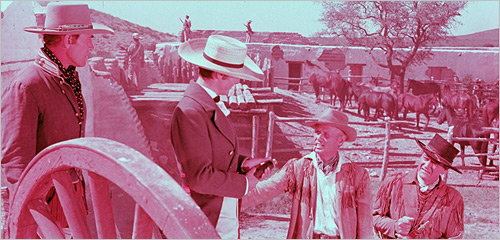
A 70mm frame of The Alamo as it exists today, prior to restoration. 
|
Corporate Donors Can Contribute to the Alamo Restoration Effort
The restoration of The Alamo will be funded via Corporate donations only. We that hope everyone who reads this column will help support this effort to return The Alamo to its full original glory. The project's charitable sponsor is now accepting contribution checks and credit cards toward the restoration of the film. All contributions are tax deductible. Contribution checks should be made out payable to... Jacob Burns Film Center, Inc. ...with the information: "f/b/o Alamo Restoration" in the memo field, normally lower left. The mailing address is: Jacob Burns Film Center 405 Manville Road Pleasantville, NY 10570 Att: Dominick Balletta Rest assured we'll keep you updated on the restoration progress here at The Bits, and you can also follow it on our official Home Theater Forum and Blu-ray.com discussion threads. Those of you who wish to contact Robert Harris can do so by sending e-mails to Bits editor Bill Hunt (billhunt@thedigitalbits.com), who will forward them on to Robert. Don't forget to check out Robert's original Yellow Layer Failure column in which he first announced the restoration project. Thanks for your support. |
Robert Siegel - Main Page
 |
| Site
designed for 1024 x 768 resolution, using 16M colors and .gif 89a
animation. © 1997-2015 The Digital Bits, Inc., All Rights Reserved. billhunt@thedigitalbits.com |